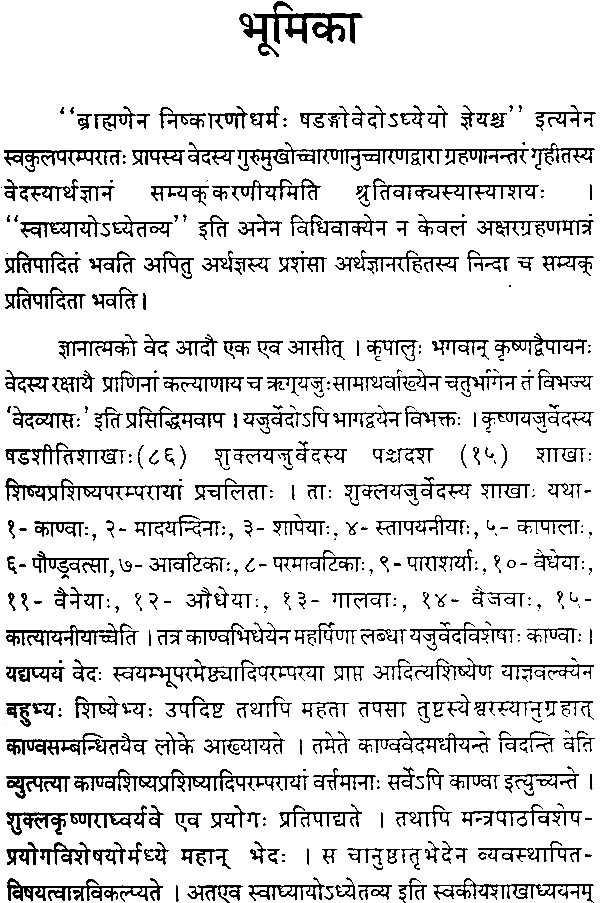Yajurveda - padapaatha, yajurveda padapaatha, padapath, padapatha,padapath,yajurveda,shukla yajurveda,पदपाठ. The name ‘Veda’ is given to the vast body of literature made up of Mantra and Brahmana. So far we have been referring mostly to Mantras which constitute the Samhita portion of the Veda, now we go to the Brahmanas.

- Author : Ralph Griffith
- Release Date : 10 April 2012
- Publisher : CreateSpace
- Categories :
- Pages : 322 pages
- ISBN 13 : 1475172613
- ISBN 10 : 9781475172614
- Format : PDF, ePUB, KF8, PDB, MOBI, AZW
Synopsis : Shukla Yajurveda written by Ralph Griffith, published by CreateSpace which was released on 10 April 2012. Download Shukla Yajurveda Books now! Available in PDF, EPUB, Mobi Format.There are two primary versions or Samhitas of the Yajurveda: Shukla (white) and Krishna (black). Both contain the verses necessary for rituals, but the Krishna Yajurveda includes the Brahmana prose discussions mixed within the Samhita, while the Shukla Yajurveda has separately a Brahmana text, the Shatapatha Brahmana. Shukla Yajurveda The Shukla Yajurveda is represented by the Vajasaneyi Samhita. The name Vajasaneyi is derived from Vajasaneya, patronymic of sage Yajnavalkya, an authority and according to tradition, founder of the Vajasaneyi branch. The Vajasaneyi Samhita has forty chapters or adhyayas, containing the formulas used with the following rituals: 1.-2.: New and Full Moon sacrifices 3.: Agnihotra 4.-8.: Somayajna 9.-10.: Vajapeya and Rajasuya, two modifications of the Soma sacrifice 11.-18.: construction of altars and hearths, especially the Agnicayana 19.-21.: Sautramani, a ritual originally counteracting the effects of excessive Soma-drinking 22.-25.: Ashvamedha 26.-29.: supplementary formulas for various rituals 30.-31.: Purushamedha 32.-34.: Sarvamedha 35.: Pitriyajna 36.-39.: Pravargya 40.: the final adhyaya is the famous Isha Upanishad -wikipedia
Shukla Yajur Veda Audiobook

Yajur Veda in Sanskrit means 'wisdom of sacrificial formulas'. This Veda compiled a century or two later than the Rig-Veda, contains prose and verse formulas that were to be pronounced by the priests performing the manual part of the sacrifice. It describes in prose the procedural details of performing different rituals and Yajnas using the hymns of the Rig Veda ( In the Vedic sacrifice a god or gods are invoked by the hymns or mantras. Offerings of food, butter, or soma are prepared and offered to the fire, which as an intermediary god, conveys these to the other gods. ) This Veda is the most important text for the priests, because it concerns itself with the correct performance of sacrifices. The priests of this Veda are called Adhwaryus.
Agni, the fire god plays a central role in the sacrifice. With the passage of time the sacrifice became increasingly elaborate, and priests became highly skilled specialists. There were many different kinds of sacrifices like the famous horse sacrifice, the soma sacrifice, sacrifices performed during various ceremonies like the Coronation ceremonies of kings, marriage ceremonies etc. Of them all the highest sacrifice was considered to be the Sarvamedha in which the sacrificer offered all of his possessions as the fee at the end of the ceremony.
The Yajur Veda seen by the outer vision is the Veda of ritual. On an inner level, it sets forth a yogic practice for purifying the mind and awakening the inner consciousness. While the lesser sacrifices win the lesser worlds, the Self-sacrifice or the AtmaYajna wins all the worlds and gains the greatest gift of immortality. Sri Chinmoy states:
Sacrifice is self-offering. Self-offering is self-fulfillment. Self-fulfillment is love-manifestation and Truth-perfection. Through our outer sacrifice we become a divine part of Mother-Earth. Through our inner sacrifice we become an immortal part of Father-Heaven. We make the outer sacrifice when we come out of the domain of binding desires and enter into the domain of liberating aspiration. We make the inner sacrifice when we try to manifest God in the world of ignorance after having achieved God-realization. The outer sacrifice demands strength of a hero. The inner sacrifice demands the power of an army. With our outer sacrifice we see the Truth. With our inner sacrifice we become the Truth.?
There are two major branches of the Yajur Veda i.e. the Krishna Yajurveda and the Shukla Yajurveda.
The Krishna Yajurveda is represented by the following recensions:
1) Taittriya
2) Kathaka
3) Maitrayani
As fire, which is one, on entering creation, conforms its own form to the form of each being, so also the One, the atman within all beings, assumes all forms, yet exists outside. As the wind, which is one, on entering creation, conforms its own form to the form of each being, so also the One, the atman within all beings, assumes all forms, yet exists outside. As the sun, the eye of the whole world, is not touched by external blemishes seen by the eye, so the One, the atman within all beings, is not touched by the sufferings of the world. He remains apart. The One, the Controller, the atman within all beings, the One who makes his own form manifold - the wise who perceive him established in themselves attain - and no others - everlasting joy.
- Krishna Yajur Veda
He who lives in us as our guide, who is one, and yet appears in many forms, in whom the hundred lights of heaven are one, in whom the Vedas are one, in whom the priests are one - He is the spiritual atman within the person.
- Krishna Yajur Veda